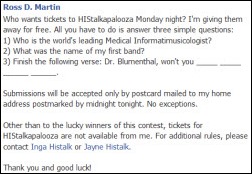Lorre’s HIMSS Conference Summary

Last week as I was staring into the House of Blues stage lights at HIStalkapalooza wearing a gown, high heels, and a sash reading, “HIStalk To Me,” I was struck by how different it was from any other job I have had. I had to pause for a moment to remember how it all happened. Twenty years ago I was a mining industry accountant and usually wore steel-toed boots and a hard hat. That seems like another lifetime now.
A seemingly random opportunity landed me in healthcare IT, where I have been for 18 years. I worked for vendors in operations leadership and business development. I have an MBA and I am an LSS Black Belt. I thrived on the never-ending challenges, non-stop travel, and endless demands for my time.
Finding myself on stage with this dream job was the culmination of a whirlwind of recent events, too many to list. I love working with the HIStalk team and I know I am in an enviable position.
HIMSS14 started for me at the beginning of September. I had just joined the HIStalk team when I met with Mr. H and Inga to discuss my role. We already agreed I was going to be responsible for the webinar program and HIStalkU, but we knew that I as the only non-anonymous member of the team could do more.
We talked about trade shows in that September meeting, but it wasn’t until the mHealth Summit offered HIStalk a free booth as a media partner that we decided to try it since we had nothing to lose other than time and travel expenses. I have been to HIMSS and AABB many times and worked in the exhibit hall. I showed up at our impressive vendor booth and stood around talking with customers and prospects all day. How hard could it be to create a micro version of that for HIStalk?

We considered mHealth Summit a trial run for HIMSS and decided to go with the bare minimum. I had never furnished a booth and the logistics are daunting. I learned that nothing comes with the booth. Mr. H and I debated about whether there would be a table at the front of our booth and decided to wait and see. We didn’t have any giveaways.
When I finally found our booth the morning before the exhibit hall opened on a snowy December day outside of Washington, DC, there was only a tiny patch of green carpet holding a chair and a trash can. There was no table or separation wall. Fortunately I was able to rent a table with a skirt and it was delivered in plenty of time. I had amazing booth neighbors who helped me hang our banner and they even let me use one of their power outlets.
There were 400 exhibitors and 5,500 attendees at mHealth. I was pleasantly surprised by how much booth traffic we generated. We weren’t selling anything or giving anything away. I was there to say thank you for reading and thank you for sponsoring, nothing more. There was a steady stream of people each day even though the conference doesn’t draw our core reader demographic. I met writers who later contributed to HIStalk and a few people interested in sponsoring. The best part was how much people just wanted to say hi and express their dedication to HIStalk. I was convinced a booth at HIMSS was a must-do.
HIMSS is a much bigger deal when compared with mHealth with 1,230 exhibitors and 37,000 attendees. It was painful trying to choose one of the available booth locations, all on the fringe and all seemingly uninteresting, but we did. We learned a lot from the mHealth Summit and acted on some great ideas for inexpensive booth signage.
Our giveaways were simple but fun. We designed two lanyard pins, one to commemorate the 10-year anniversary of HIStalk this past June and the other representative of our first HIMSS conference as an exhibitor. We had coffee mugs printed with the top HIT news stories of 2013 according to HIStalk. They turned out to be a hit, and even readers who didn’t attend the conference have asked for the pins and the mugs.
When I visited the exhibit hall Sunday afternoon, I was shocked to find it far from ready for the next day. Some of the giant booths looked only half built, debris was everywhere, and forklifts raced dangerously back and forth. I couldn’t imagine everything being ready in time to open the hall at noon on Monday. I wanted to deliver the HIStalk sponsor booth signs, but the hall was such a mess and the odds of being struck by a forklift were so high that I decided to wait.
I hosted a cocktail reception for our sponsors Sunday evening. It went smoothly and everyone said they had a great time. I met a lot of interesting and energetic people and I was impressed by their obvious affinity for HIStalk. Dr. Gregg was on hand to assist me and Inga and Dr. Jayne spent some time there (anonymously, of course.) Even Mr. H made a quiet appearance, after which he left just as quietly.
Monday morning I arrived at the exhibit hall early and raring to go. I had to hustle to cover every square foot of the exhibit hall, my arms loaded with signs. Thankfully Dr. Gregg was there, too, and when we realized I was running out of time, he helped me get it done. According to my Fitbit, I exceeded my 10,000 steps/five miles goal before 10 a.m.
Our little booth was quite a way from the major thoroughfares, so I was surprised by the immediate flow of visitors when the exhibit hall opened. It was consistent throughout the show. Countless readers and sponsors stopped by to say hello and to tell me how much they love HIStalk. We had even heavier traffic when one of our VIP guests (Ed Marx, Vince Ciotti, and Robert Murphy, MD) greeted their fans in our booth.
Once again, Dr. Gregg was a life saver. Not only did he help me with the booth setup and delivering the signs, he gave me breaks throughout each day so the non-stop visitors wouldn’t be disappointed to find an empty booth. Mike Cannavo (“The PACSman”) was also a blessing. He covered the booth, brought me lunch, and kept our swag collection current. The number of people visiting our booth was so remarkable that someone in the booth next to ours asked, “What are you selling?” I smiled when I replied that we are selling nothing — we are just saying hello and thank you.
There was so much fun on and off each day that it would be impossible to mention it all. My top 10 are:
- Working with the people in the Epic booth to stage a picture of them looking at their cell phones
- Watching people apply temporary tattoos to the strangest places (Ed Marx takes the prize for his lower back tramp stamp)
- Arriving at the booth one morning to find a box of warm scones from MedData
- Handing out the HIStalk sponsor booth signs and seeing how everyone lit up
- Chatting with Ed Marx, Vince, and Dr. Murphy
- Seeing the women who stopped by to show me their shoes
- Having Inga, Dr. Jayne, and even Mr. H stop by the booth without anyone realizing it except me
- Receiving my own copy of Struck by Orca
- Trying on a Super Bowl ring
- Receiving countless comments and compliments and passing them along to the team
I reconnected with many colleagues and customers from the past. I receive e-mails regularly from people who see my LinkedIn profile and wonder if working for HIStalk is a real job. Talking with them wasn’t any different. Yes, it is a real job, although it is fun and exciting and it doesn’t usually feel like work. I love to chat with readers and sponsors and work on webinars. I get a lot of satisfaction from helping them develop and deliver interesting and educational productions.
The event that was a personal stretch for me came when Mr. H asked me to accept HIStalk’s “Sunquest Industry Pioneer Award.” In my 16 years working for Sunquest, I received many opportunities to learn and grow and I almost always loved it. The same team presenting the award fired me two years ago. I can almost hear the collective gasp — why would I admit something like that publicly, and in writing no less? Let’s face it — we are all one merger, acquisition, unattainable goal, or difference of opinion away from being redundant or no longer a fit for the position. It isn’t personal. I showed up at the booth and everyone was friendly and warm. The HIStalk team stood within earshot and watched proudly. I thanked Sunquest not only for the award, but for their support and sponsorship of HIStalk. It was closure and it felt good.
Participating in the planning of an event like HIStalkapalooza was a whole new experience for me. Since the sponsor is responsible for it, it should be easy for the HIStalk team, right? No way! There is constant back and forth interaction and negotiation. It isn’t easy to strike a balance between what our readers and sponsors expect and what the sponsors of the event think they should get out of it. It was both frustrating and fun to be part of it. I learned a lot, along with everyone else, and I’m sure next year will be better because of it. The event itself was a huge success. The HISsies were entertaining and Farzad, Carl, and Ed all made an appearance to accept their awards. The food was terrific and people raved about the band for days afterward. Imprivata and all of the co-sponsors did a great job.
HIMSS14 was great for me. I met a lot of terrific people, I gained a whole new appreciation for those responsible for planning events, and I had fun. I am already thinking about what to do next year in Chicago.
Email Lorre or follow her on Twitter.


























































































































































"most people just go to Epic" that's a problem because then EPIC becomes a monopoly in healthcare, if it isn't…